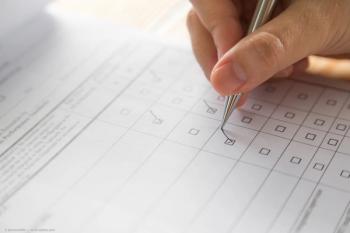
Novel neurostimulator device uses nasal cavities to stimulate tears
Chronic dry eye disease (DED) affects more than 25 million people and to date the only pharmacologic therapies are topical or involve punctal plugs. Results from two studies wth a neurostimulator indicate there may be a new pathway to upregulate the body’s tear system.
Editor’s note: Since the time of these presentations, Allergan submitted a de novo application for the Oculeve Intranasal Tear Neurostimulator device. According to the FDA, this process provides a pathway for medical devices for which general and/or special controls provide a reasonable assurance of safety and effectiveness, but for which there is no legally marketed predicate device.
Chronic dry eye disease (DED) affects more than 25 million people and to date the only pharmacologic therapies are topical or involve punctal plugs.
Results from two studies wth a neurostimulator indicate there may be a new pathway to upregulate the body’s tear system.
The device (Oculeve Intranasal Tear Neurostimulator, Allergan) comprises a disposable tip with hydrogel that tops a durable, rechargable stimulator unit, said John Berdahl, MD, Vance Thompson Vision, Sioux Falls, SD. Five levels of patient-adjusted stimulation are part of the device as well.
The device was developed at Stanford University by Michael Ackermann, PhD; James Loudin, PhD; and Daniel Palanker, PhD.
New evidence
Stephen C. Pflugfelder, MD, chair and professor of ophthalmology, Baylor College of Medicine, Houston, said clinicians now know tear secretion is regulated by the lacrimal functional unit, and that the nasal cavities play a role.
“Schirmer with nasal stimulation with a cotton-tip applicator is recognized to induce reflex tearing,” Dr. Pflugfelder said, “Nasal anesthesia decreases tear production by 34% in normal subjects.”
Goblet cells secrete mucin in response to neural stimulation, he added.
Several publications confirm dry eye may disrupt neural signaling of tear secretion by decreased corneal sensitivity, anticholingergic medications, autoantibodies to acetylcholine receptors, or inflammatory cytokines, Dr. Pflugfelder said.
Pathway advantange
The device “takes advantage of these natural neurostimulatory pathways,” he said. “It delivers a titratable intranasal electrical stimulus to stimulate tearing.”
In a randomized control trial (n=16), primary entry criteria included a Schirmer score of 10 mm or less, and an OSDI score of at least 23, Dr. Berdahl said. In this study, the mean patient age was 57.6 years, and 9 patients (56%) were female.
Keratography showed an immediate response to stimulation, as video confirmed the buildup of tears as the patient is using the device.
The device increased Schirmer scores to 29.2 mm (compared with 15.5 mm for the placebo and 15.3 mm for the sham), which was statistically and clinically significant.
Further, the device has a favorable safety profile, Dr. Berdahl said, with none of the adverse events related to the device (but were related to the Schirmer testing).
In asecond study, Arturo Chayet, MD, Codet Vision Institute, Tijuana, Mexico, enrolled 40 patients (mean age 54.6 years, and 85% were female) with a wide range of disease severity.
Baseline criteria for his non-randomized, open-label trial included a Schirmer score of 15 mm or less, and an OSDI score of at least 13.
Schirmer scores with stimulation increased relative to baseline in both eyes, with the stimulated eye at 22 mm at day 0, which was maintained at 20 mm at day 180. The unstimulated eye improved Schirmer scores from 9 mm at day 0 to 13 mm at day 180.
“Corneal staining was not an entry criterion, but more than half of patients (n = 22) had staining of under 2 at baseline,” Dr. Chayet said.
Of the 18 patients with baseline staining scores over 2, the mean reduction was 2.4 at day 180, he said. Conjunctival staining (also not an entry criterion) was also reduced relative to baseline in both eyes.
“All patient-reported symptoms were reduced at day 180 relative to baseline,” Dr. Chayet said, with noticeable reductions around day 10. A patient survey found 70% would use the stimulator again and more than 80% would recommend the device.
There were no serious adverse events in the 17,863 cstimulation events, he said, and two non-serious events were related to the device.
Dr. Pflugfelder evaluated the ratio of degranulated and non-degranulated goblet cells between intranasal and extranasal applications using anterior segment optical coherence tomography to measure tear meniscus height in patients with dry eye disease.
Inclusion criteria included a tear break-up time of 7 seconds or less, an OSDI score of at least 23, a nasal-stimulated Schirmer score that increased at least 7 mm, and a tear meniscus height of 230 µm or less.
“Stimulated goblet cell degranulation was seen in normal and dry eyes,” Dr. Pflugfelder said. “Degranulation occurred in the inferior and temporal bulbar conjunctiva. These outcomes were significantly higher in the intranasal group than in the sham group.”
Other findings confirmed the device stimulates aqueous tear secretion at the same time that it causes goblet cell secretion, he said. Greater tear meniscus height and area were found after stimulation compared to sham or baseline.
“Nasal neurostimulation is an exciting new treatment modality for dry eye,” Dr. Pflugfelder concluded.
John Berdahl, MD
E: [email protected]
Stephen C. Pflugfelder, MD
E: [email protected]
Arturo Chayet, MD
E: [email protected]
This article was adapted from presentations delivered by Drs. Berdahl, Pflugfelder, and Chayet at the 2016 American Society of Cataract and Refractive Surgery meeting. Drs. Berdahl and Plugfelder are consultants for Allergan.
Newsletter
Don’t miss out—get Ophthalmology Times updates on the latest clinical advancements and expert interviews, straight to your inbox.
















































.png)


